At 6:30pm on Monday evening, April 15, 2019, the Cathedral of Notre-Dame de Paris began to burn.
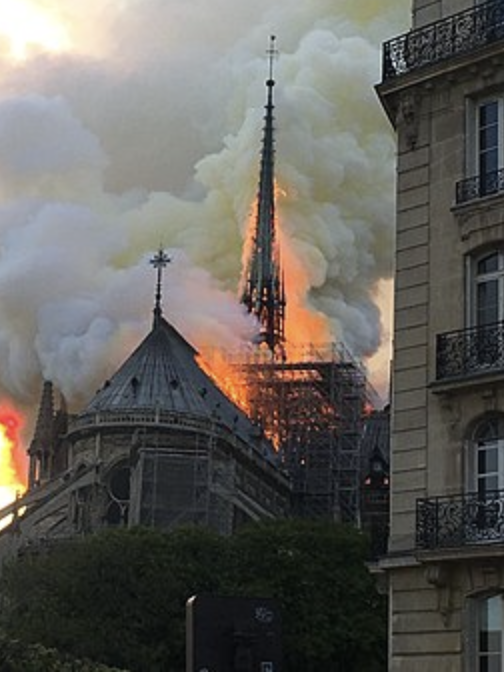
Notre-Dame Cathedral’s spire on fire on April 15, 2019. Image courtesy Antoninnnnn via Wikimedia Commons.
Considered a jewel of Gothic architecture, the inferno began in what has been referred to as the “forest” of wooden beams inside the Cathedral’s roof. These beams caught fire and collapsed – a big issue, because the wooden forest of beams had provided much-needed support for the entire structure. After the beams disintegrated, the Cathedral crumbled. Onlookers, who yearned for the building to be saved from disaster, lost hope. As the Cathedral sank, smoke and dust rose to overtake the horizon.
Four years later, the darkness has cleared and hope abounds. The shock felt by millions around the world has softened, and the Cathedral’s on-going renovation is chugging along like the Little Engine that Could.
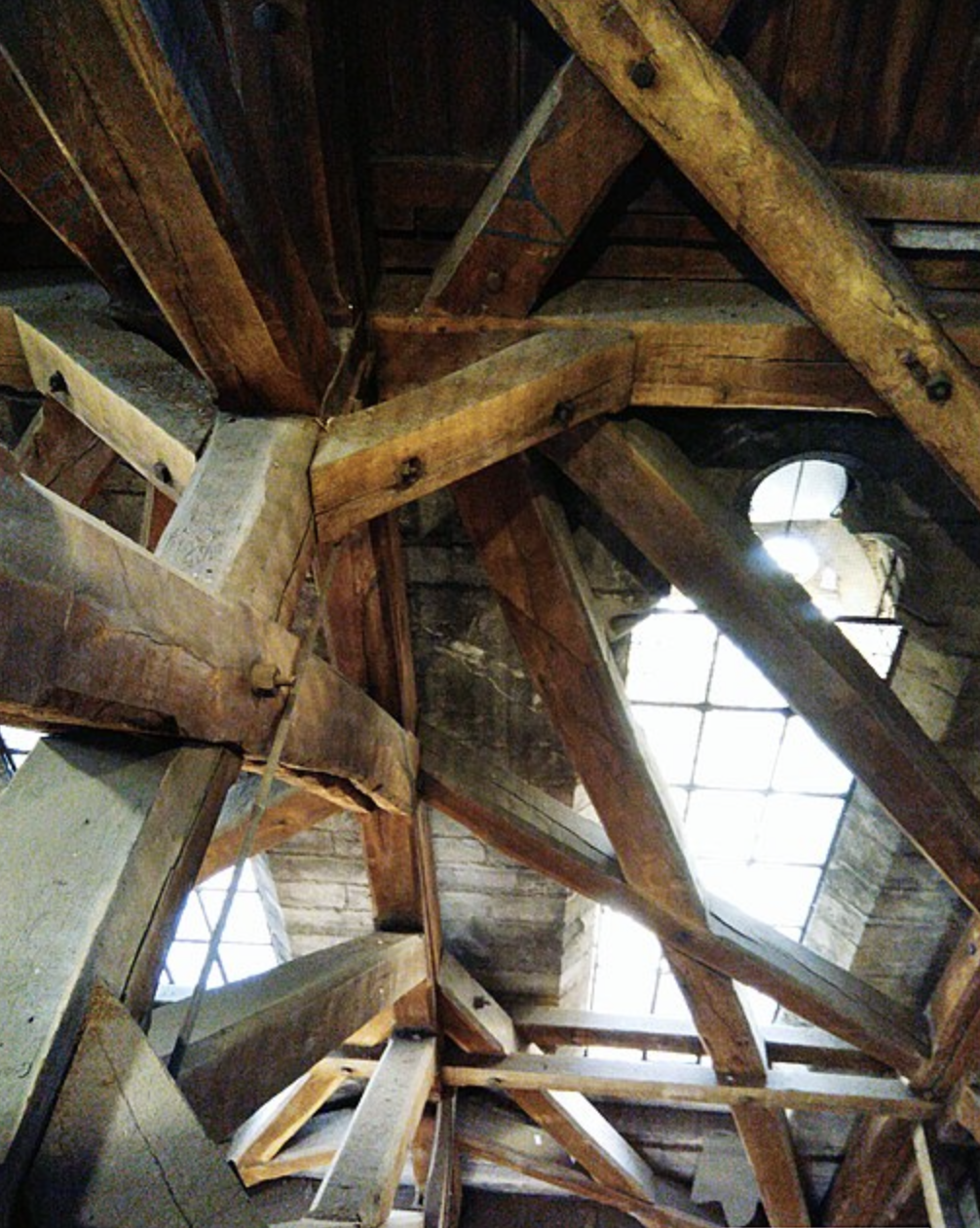
The inner framework of Notre-Dame, just months before the 2019 fire. Image courtesy SamuelPrr14 via Wikimedia Commons.
However, this chugging along is certainly that – a slow, steady pace. Originally, an anticipated re-opening date was set for April 19, 2024. This date would have been ideal as it is the fifth anniversary of the fire. Yet, due to delays, that plan has been scrapped. Several things have gotten in the way of the original timeframe (two major ones being a global pandemic and the outbreak of war in Ukraine).
Renovators, seeing that the finish line was not quite in sight to make that deadline, made adjustments. “Plan B” was to have the project finished by the summer of 2024. This would have meant that the reveal of refreshed cathedral would coincide with Paris’s highly anticipated 2024 Summer Olympic Games. Unfortunately, that plan has also been scrapped and tossed in the rubble. The newest official re-opening goal date is set for December 2024.
However, it is important to understand what “re-opening” entails. December 2024 is unlikely to mark the completion of all necessary renovations. Total completion by this date is not the goal; rather, it is to have the space ready to celebrate Catholic Mass by that time. As Culture Minister Rima Abdul-Malak explained, while tourists will be able to visit the site in late 2024 and attend Mass, renovations will continue into 2025.
Does it seem strange to celebrate Catholic liturgy in a half-finished construction site? Perhaps, but the French are the ultimate authority on the “chic, messy effortlessness” that results from a project left not-quite-done. Plus, those feeling impatient may quench their thirst for Notre-Dame de Paris by arriving in Paris, post-haste! A new exhibition has opened, entitled “Notre-Dame de Paris: at the heart of the construction site.” Visitors can expect to reap the inside scoop of the on-going renovation, plus view some remains from the fire, as well as salvaged artwork from the Cathedral.
In truth, the delays that have pushed back the opening, and made the aforementioned exhibit possible, are likely a good sign. The extended time for renovations signifies the seriousness and care being put into this renovation by the expert team on the ground in Paris. This is not surprising, seeing that the Cathedral is a highlight along tourists’ itineraries, and the structure has inspired generations of artists and writers.
The situation is as poet Mary Oliver wrote: “Things take the time they take. Don’t worry. How many roads did St. Augustine travel, before he became St. Augustine?”
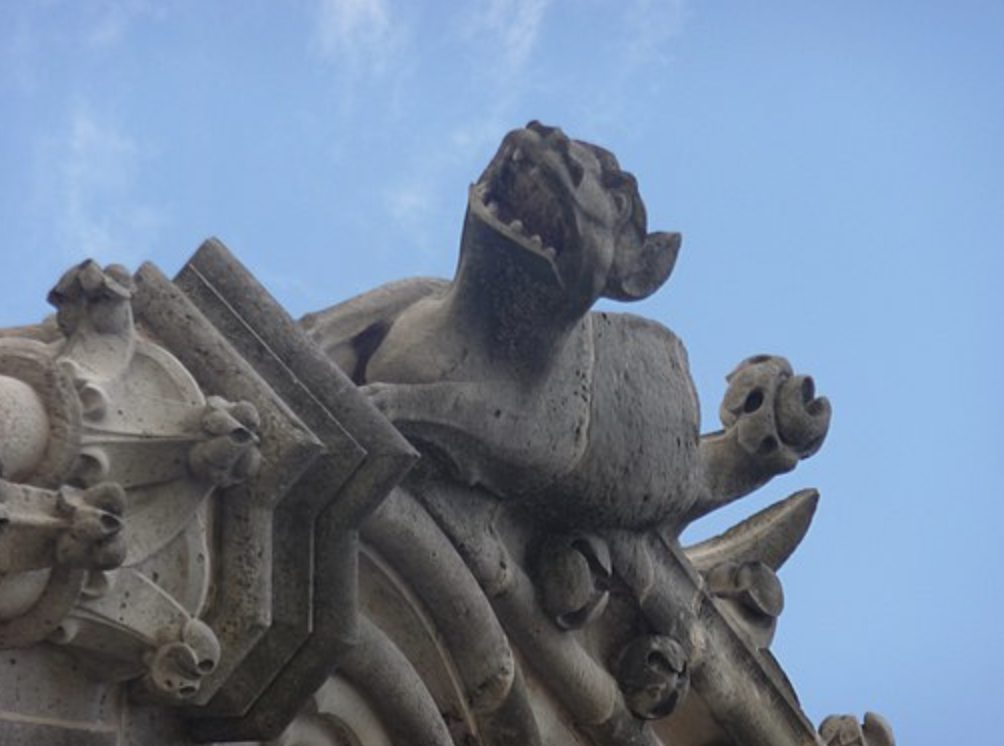
One of the classic gargoyles atop Notre-Dame, photographed in 2016. Image courtesy Marcok via Wikimedia Commons.
Who is the genius leading this team of experts? The man entrusted with this special renovation project is none other than famed architect Philippe Villeneuve. According to Paris’s Official Tourism site, Villeneuve’s plan from the get-go has been to “rebuild the cathedral identically, including the spire.” The architect’s mission to retain the building’s original structure seems to be the foundation from which all other decisions are made. Even so, some of the plans have departed from the Cathedral’s original design. This has caused quite a bit of drama. The reason for the drama is that, unsurprisingly, there have been a lot of opinions about how the phoenix of Notre-Dame de Paris should rise from the ashes.
The online rumor mill has added fuel to the fire. Last year, rumors surfaced regarding plans to depart from the Cathedral’s original plans, sacrificing austerity for new tech and additional features. This caused widespread concern among art experts and historians that the Diocese of Paris was attempting its own “woke Disney revamp.” Plans to create features such as “emotional spaces” and “a discovery tour” sparked French academics to doom the proposals as an example of “inanity [meeting] kitsch.”
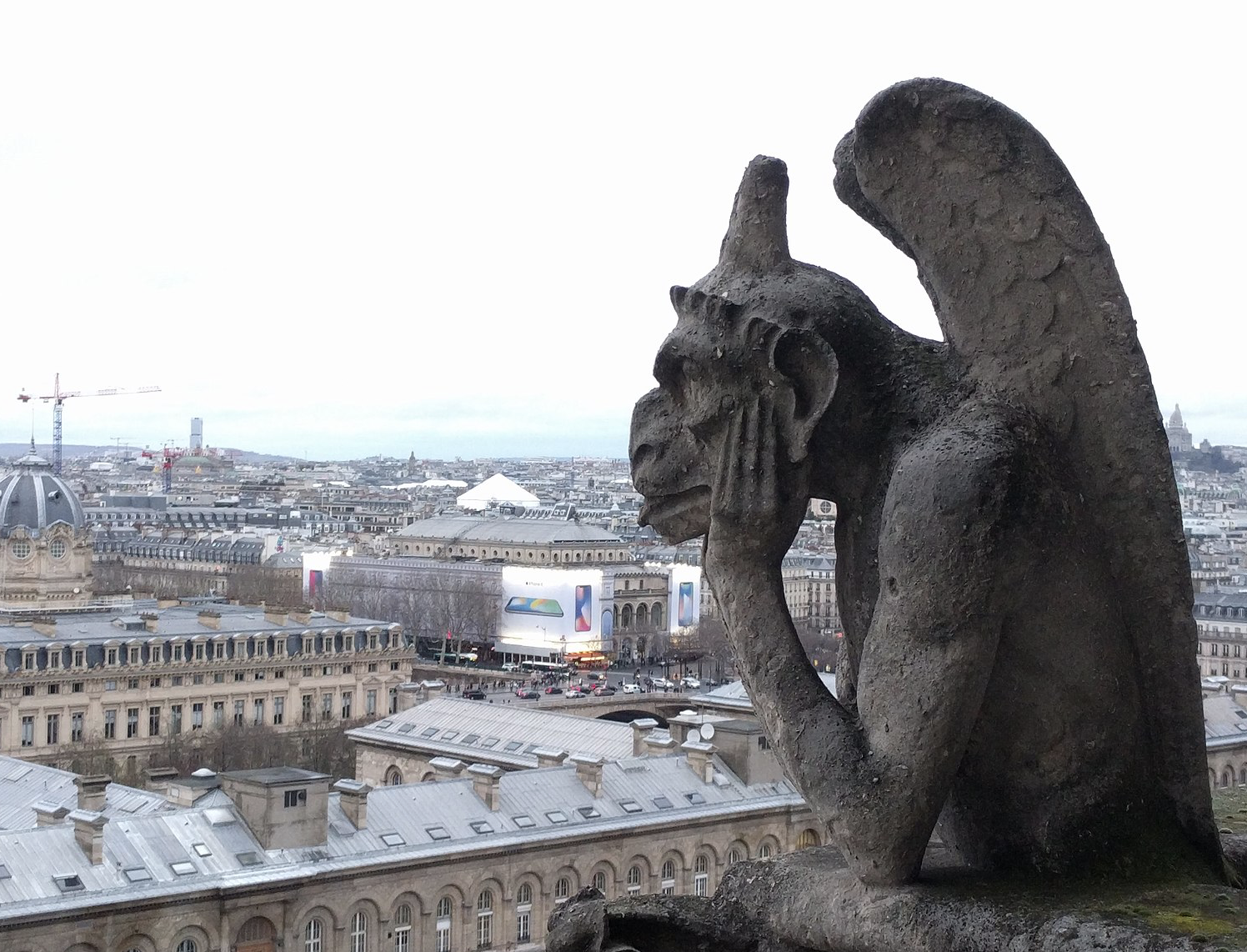
A contemplative gargoyle on the North Bell Tower in 2018, perhaps foreseeing the coming fire. Image courtesy Mari Doucet via Wikimedia Commons.
The “woke Disney revamp” comments ironically threw serious shade on the media powerhouse that brought new fame to Notre-Dame in the 1990s with the release of the animated film The Hunchback of Notre Dame. When approached for comment about the unfavorable comparison, Mr. Mickey Mouse chose not to respond. Those familiar with the matter claim that Mr. Mouse had suggested sending a “poop emoji” to the art historians’ to counter the vitriolic attack, but was dissuaded by publicity experts from doing so.
Despite criticism of any change from the original design, France’s National Heritage and Architecture Commission has approved several proposals integrating modern updates. These include installing modern lighting and contemporary works. Strong adherents to the traditional Gothic integrity of the space oppose such changes; on the other side, the Cathedral’s pastoral staff claim that some changes to the original plan will make the experience of visiting the Cathedral more enjoyable overall.
Additional controversial proposed changes favored by the Diocese include moving the tabernacle and other sacred objects. The purpose behind these changes is to encourage more of a dialogue between the visitor and the Gothic architecture of the sacred space when walking through the space. French authorities hope that these changes will retain the traditional feel of the original layout, while “bringing more a little more sense to the visitor.” As these changes seem directed at easing crowd flow for when the Cathedral is once again a major tourist site, they have faced fewer critics.
Lookout for the Spire
When word broke loose that there were plans to significantly change the monument’s overall architecture, the French Government got involved, to make sure that crucial elements of the Cathedral remain the same. At one point, a change to the iconic look of Notre-Dame was suggested in the form of a new, more modern spire. In response, President Emmanuel Macron intervened. He had been approached by cultural heritage experts who convinced him that a dramatic overhaul in design would drastically alter the integrity of the globally recognized monument. Macron stepped in to nix the change and prevent the 19th-century spire from being replaced with a more contemporary update. Reconstruction of the spire did not start until last year, because the monument itself had to undergo significant reconstruction to be able to support the 315 ft spire. True to his word, Macron has ensured that the new spire will match the one lost by fire. Those scanning the Parisian skyline will once again see the fabled towers in renewed glory.
A History of Renovations
Many people will be surprised to learn that the so-fought-for spire was not, in fact, part of the original 12th century Gothic design. The iconic Notre-Dame de Paris spire that the world knows and loves was added in the 19th century, by architect Eugène Voillet-le-Duc. Voillet-le-Duc’s involvement was the result of a major renovation effort at that time, spurred into life by renewed interest in the Cathedral following Victor Hugo’s famed tale.
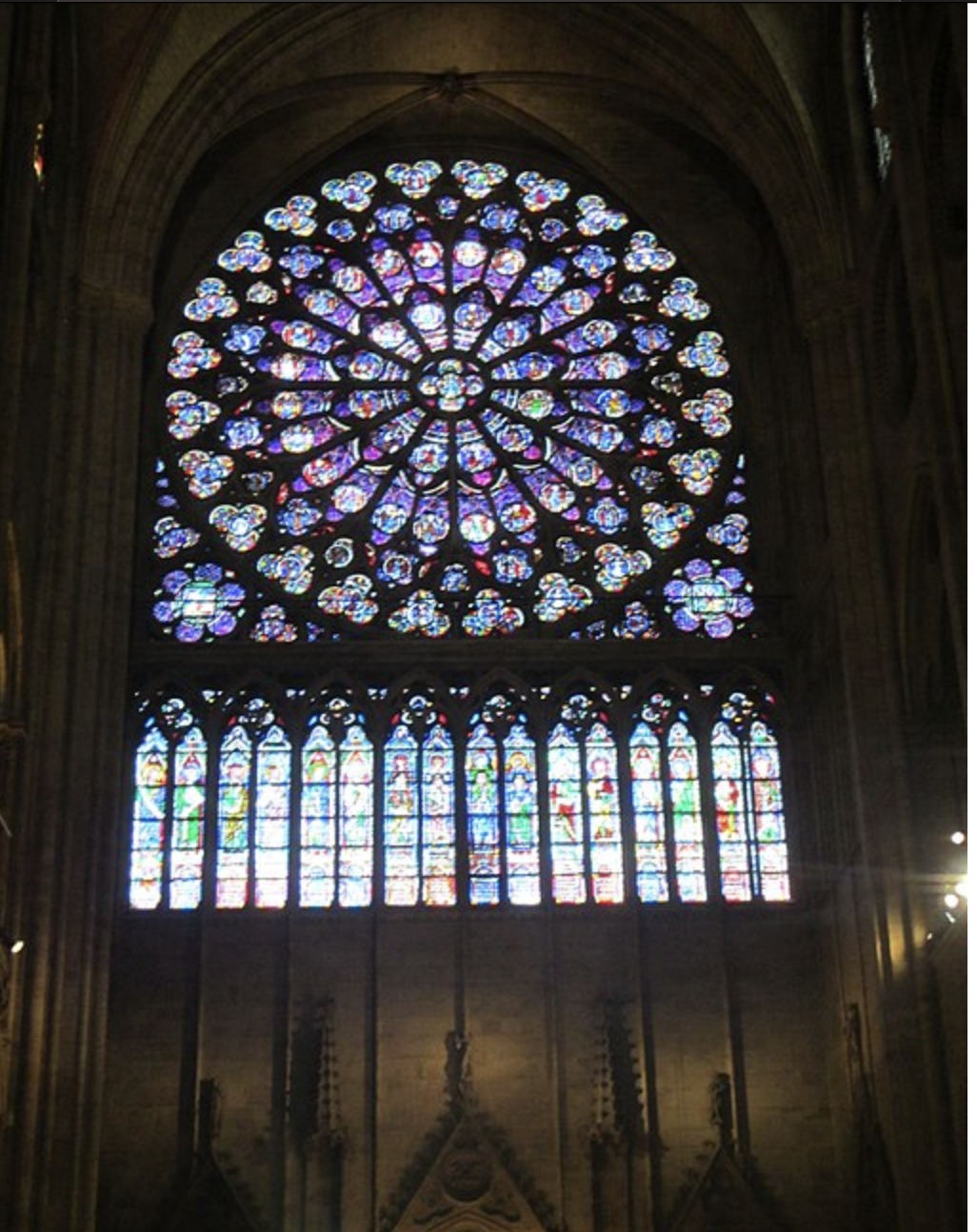
Notre Dame Rose Window in 2014. Image courtesy Jeremy Hylton via Wikimedia Commons.
That effort led by Voillet-le-Duc marked the most recent major renovation of Notre-Dame de Paris, but not its first major revamp. In 1699, the Cathedral received a major facelift in 1699, courtesy of the redecoration effort led by Hardouin Mansart and Robert de Cotte. Prior to that, several reconstruction and renovation efforts occurred, including the installment of the north and south rose windows.
In fact, the entire conception of Notre-Dame de Paris as we know it was the result of a major reconfiguration of sacred space. The original construction of Notre-Dame de Paris, commissioned by Bishop Maurice de Sully in 1163, replaced a demolished 4th century Cathedral of Saint Étienne. In that sense, one could argue that Notre-Dame de Paris has been an HGTV special from Day One.
The Future of Notre-Dame
Will this next reveal mark the final glow-up of this storied monument’s life? Or is this version of Notre-Dame de Paris simply another notch in the belt of this hero’s journey? If anything, this is a cathedral that has proved it knows how to reinvent itself and start anew. Plus, with the aid of new technology, the state-of-the-art Cathedral will be even more regal than before. Hopefully, 2019 was the last time Notre-Dame de Paris will face a fire. A renewed and refreshed cathedral will be worth the wait – and will stand for many centuries to come as a symbol of courage and resilience in the face of inferno.